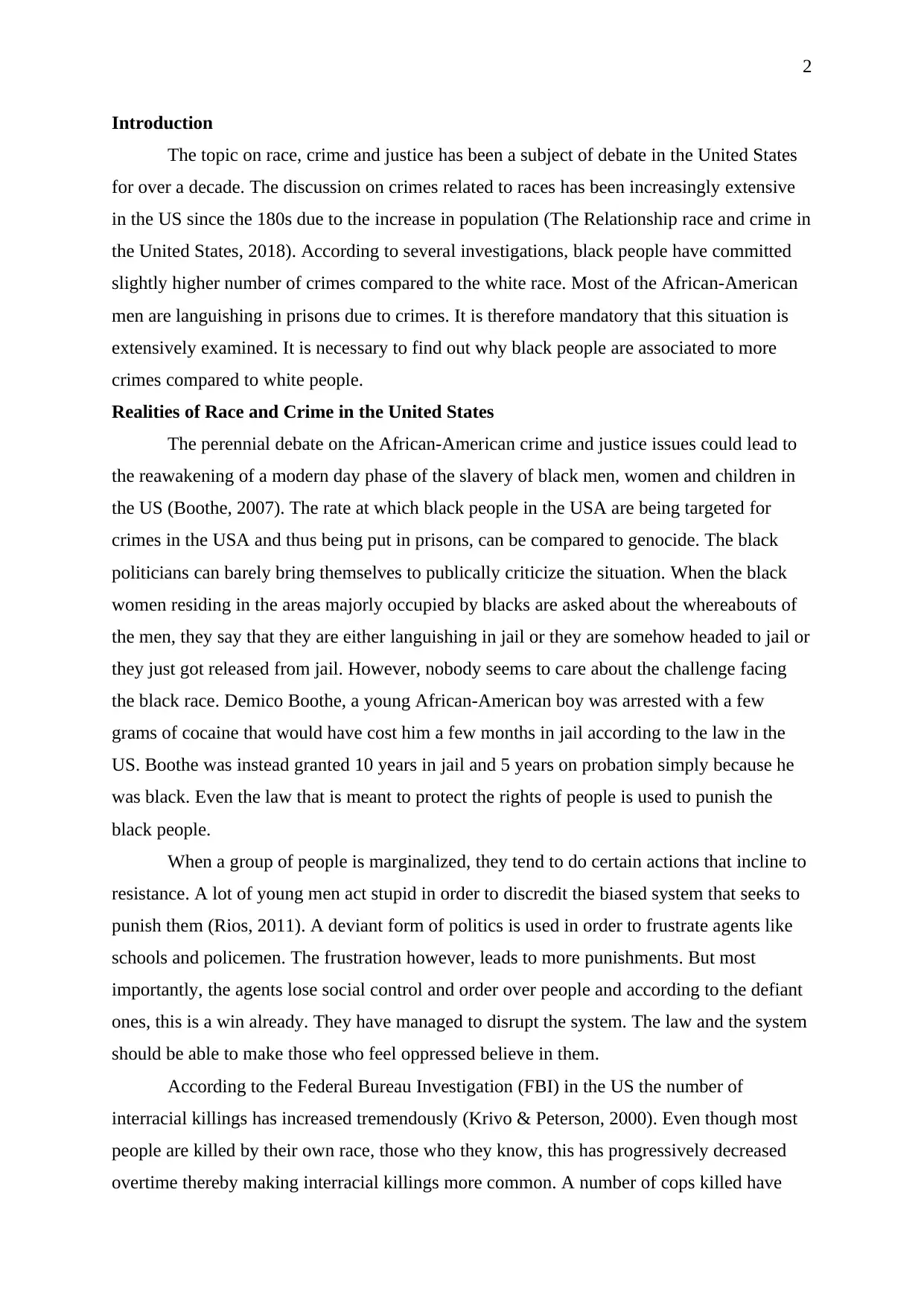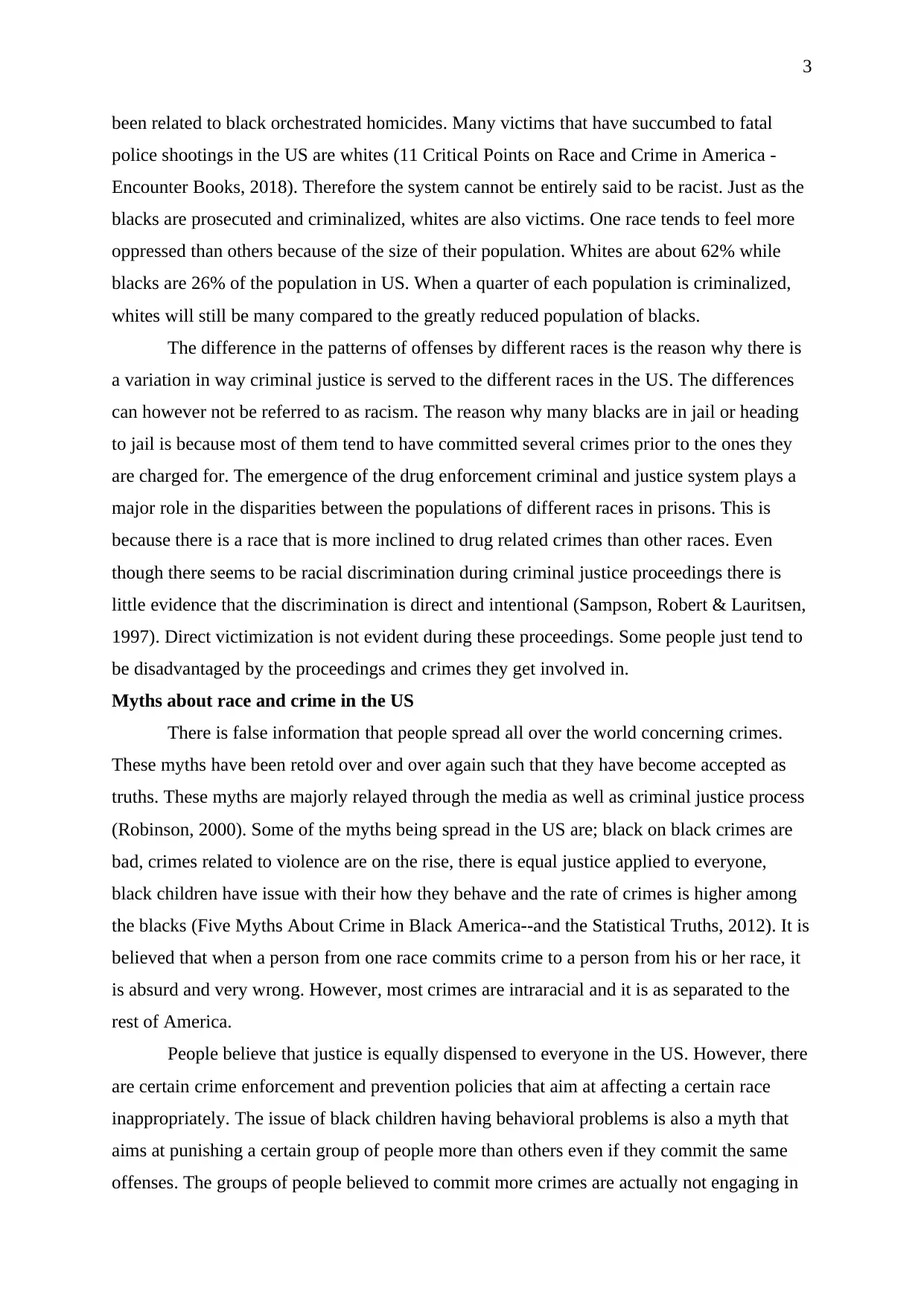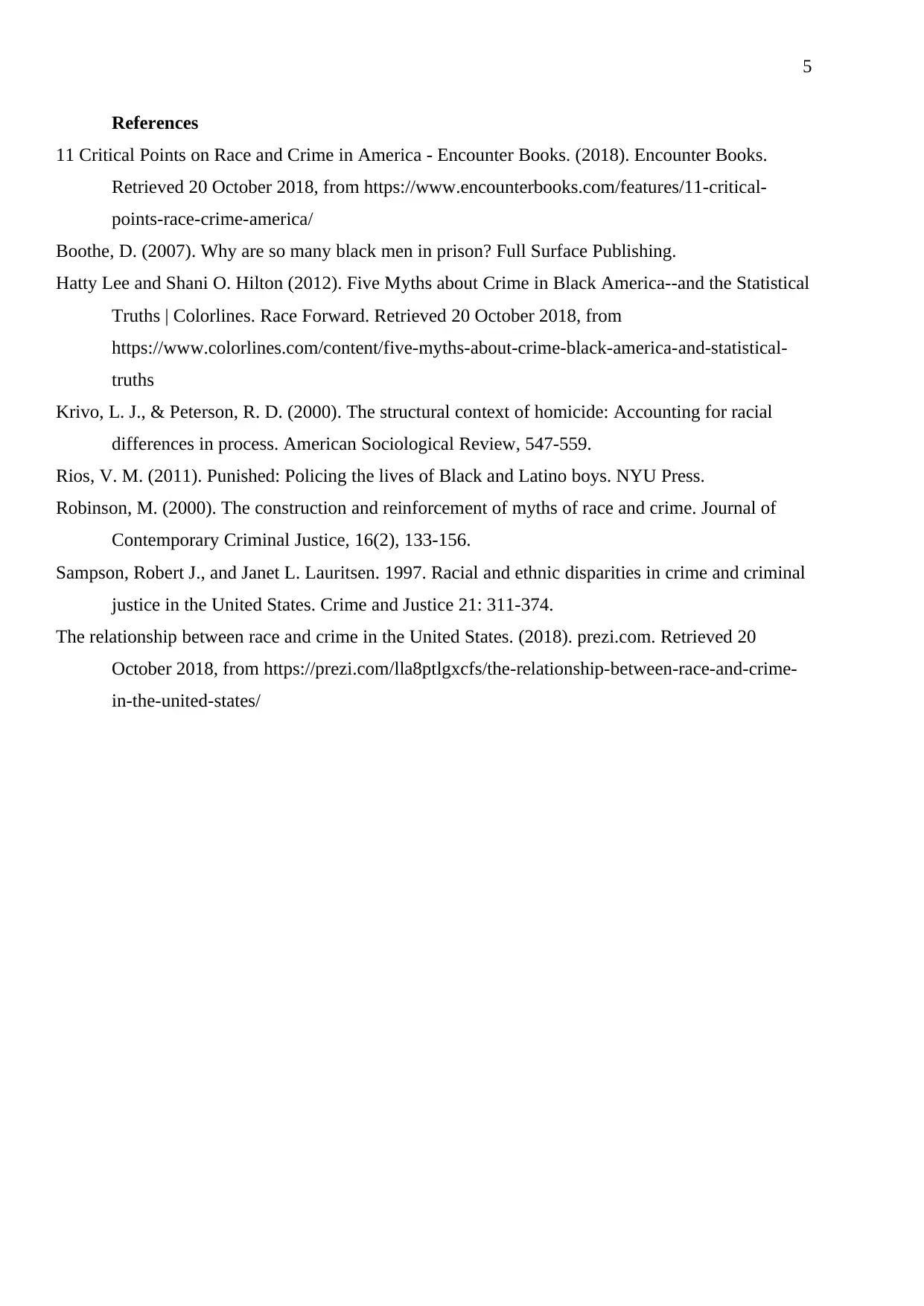Understanding Race, Crime, and Justice System in the United States
VerifiedAdded on 2023/06/04
|5
|1369
|151
Essay
AI Summary
This essay examines the intricate relationship between race, crime, and justice in the United States, highlighting the disproportionate representation of African-Americans in the criminal justice system. It delves into the historical context, including the legacy of slavery, and analyzes factors contributing to racial disparities in arrests, convictions, and sentencing. The essay also addresses common myths surrounding race and crime, such as the notion of equal justice for all and the prevalence of black-on-black crime, while emphasizing the need for a non-judgmental understanding of crime to ensure fairness and equity in the justice system. The essay concludes by referencing studies and reports that shed light on the structural and systemic issues perpetuating racial inequality in the US criminal justice system.

Running Head: RACE AND CRIME 1
Race Crime and Justice in the United States of America
Student’s Name
Student’s ID
Race Crime and Justice in the United States of America
Student’s Name
Student’s ID
Paraphrase This Document
Need a fresh take? Get an instant paraphrase of this document with our AI Paraphraser

2
Introduction
The topic on race, crime and justice has been a subject of debate in the United States
for over a decade. The discussion on crimes related to races has been increasingly extensive
in the US since the 180s due to the increase in population (The Relationship race and crime in
the United States, 2018). According to several investigations, black people have committed
slightly higher number of crimes compared to the white race. Most of the African-American
men are languishing in prisons due to crimes. It is therefore mandatory that this situation is
extensively examined. It is necessary to find out why black people are associated to more
crimes compared to white people.
Realities of Race and Crime in the United States
The perennial debate on the African-American crime and justice issues could lead to
the reawakening of a modern day phase of the slavery of black men, women and children in
the US (Boothe, 2007). The rate at which black people in the USA are being targeted for
crimes in the USA and thus being put in prisons, can be compared to genocide. The black
politicians can barely bring themselves to publically criticize the situation. When the black
women residing in the areas majorly occupied by blacks are asked about the whereabouts of
the men, they say that they are either languishing in jail or they are somehow headed to jail or
they just got released from jail. However, nobody seems to care about the challenge facing
the black race. Demico Boothe, a young African-American boy was arrested with a few
grams of cocaine that would have cost him a few months in jail according to the law in the
US. Boothe was instead granted 10 years in jail and 5 years on probation simply because he
was black. Even the law that is meant to protect the rights of people is used to punish the
black people.
When a group of people is marginalized, they tend to do certain actions that incline to
resistance. A lot of young men act stupid in order to discredit the biased system that seeks to
punish them (Rios, 2011). A deviant form of politics is used in order to frustrate agents like
schools and policemen. The frustration however, leads to more punishments. But most
importantly, the agents lose social control and order over people and according to the defiant
ones, this is a win already. They have managed to disrupt the system. The law and the system
should be able to make those who feel oppressed believe in them.
According to the Federal Bureau Investigation (FBI) in the US the number of
interracial killings has increased tremendously (Krivo & Peterson, 2000). Even though most
people are killed by their own race, those who they know, this has progressively decreased
overtime thereby making interracial killings more common. A number of cops killed have
Introduction
The topic on race, crime and justice has been a subject of debate in the United States
for over a decade. The discussion on crimes related to races has been increasingly extensive
in the US since the 180s due to the increase in population (The Relationship race and crime in
the United States, 2018). According to several investigations, black people have committed
slightly higher number of crimes compared to the white race. Most of the African-American
men are languishing in prisons due to crimes. It is therefore mandatory that this situation is
extensively examined. It is necessary to find out why black people are associated to more
crimes compared to white people.
Realities of Race and Crime in the United States
The perennial debate on the African-American crime and justice issues could lead to
the reawakening of a modern day phase of the slavery of black men, women and children in
the US (Boothe, 2007). The rate at which black people in the USA are being targeted for
crimes in the USA and thus being put in prisons, can be compared to genocide. The black
politicians can barely bring themselves to publically criticize the situation. When the black
women residing in the areas majorly occupied by blacks are asked about the whereabouts of
the men, they say that they are either languishing in jail or they are somehow headed to jail or
they just got released from jail. However, nobody seems to care about the challenge facing
the black race. Demico Boothe, a young African-American boy was arrested with a few
grams of cocaine that would have cost him a few months in jail according to the law in the
US. Boothe was instead granted 10 years in jail and 5 years on probation simply because he
was black. Even the law that is meant to protect the rights of people is used to punish the
black people.
When a group of people is marginalized, they tend to do certain actions that incline to
resistance. A lot of young men act stupid in order to discredit the biased system that seeks to
punish them (Rios, 2011). A deviant form of politics is used in order to frustrate agents like
schools and policemen. The frustration however, leads to more punishments. But most
importantly, the agents lose social control and order over people and according to the defiant
ones, this is a win already. They have managed to disrupt the system. The law and the system
should be able to make those who feel oppressed believe in them.
According to the Federal Bureau Investigation (FBI) in the US the number of
interracial killings has increased tremendously (Krivo & Peterson, 2000). Even though most
people are killed by their own race, those who they know, this has progressively decreased
overtime thereby making interracial killings more common. A number of cops killed have

3
been related to black orchestrated homicides. Many victims that have succumbed to fatal
police shootings in the US are whites (11 Critical Points on Race and Crime in America -
Encounter Books, 2018). Therefore the system cannot be entirely said to be racist. Just as the
blacks are prosecuted and criminalized, whites are also victims. One race tends to feel more
oppressed than others because of the size of their population. Whites are about 62% while
blacks are 26% of the population in US. When a quarter of each population is criminalized,
whites will still be many compared to the greatly reduced population of blacks.
The difference in the patterns of offenses by different races is the reason why there is
a variation in way criminal justice is served to the different races in the US. The differences
can however not be referred to as racism. The reason why many blacks are in jail or heading
to jail is because most of them tend to have committed several crimes prior to the ones they
are charged for. The emergence of the drug enforcement criminal and justice system plays a
major role in the disparities between the populations of different races in prisons. This is
because there is a race that is more inclined to drug related crimes than other races. Even
though there seems to be racial discrimination during criminal justice proceedings there is
little evidence that the discrimination is direct and intentional (Sampson, Robert & Lauritsen,
1997). Direct victimization is not evident during these proceedings. Some people just tend to
be disadvantaged by the proceedings and crimes they get involved in.
Myths about race and crime in the US
There is false information that people spread all over the world concerning crimes.
These myths have been retold over and over again such that they have become accepted as
truths. These myths are majorly relayed through the media as well as criminal justice process
(Robinson, 2000). Some of the myths being spread in the US are; black on black crimes are
bad, crimes related to violence are on the rise, there is equal justice applied to everyone,
black children have issue with their how they behave and the rate of crimes is higher among
the blacks (Five Myths About Crime in Black America--and the Statistical Truths, 2012). It is
believed that when a person from one race commits crime to a person from his or her race, it
is absurd and very wrong. However, most crimes are intraracial and it is as separated to the
rest of America.
People believe that justice is equally dispensed to everyone in the US. However, there
are certain crime enforcement and prevention policies that aim at affecting a certain race
inappropriately. The issue of black children having behavioral problems is also a myth that
aims at punishing a certain group of people more than others even if they commit the same
offenses. The groups of people believed to commit more crimes are actually not engaging in
been related to black orchestrated homicides. Many victims that have succumbed to fatal
police shootings in the US are whites (11 Critical Points on Race and Crime in America -
Encounter Books, 2018). Therefore the system cannot be entirely said to be racist. Just as the
blacks are prosecuted and criminalized, whites are also victims. One race tends to feel more
oppressed than others because of the size of their population. Whites are about 62% while
blacks are 26% of the population in US. When a quarter of each population is criminalized,
whites will still be many compared to the greatly reduced population of blacks.
The difference in the patterns of offenses by different races is the reason why there is
a variation in way criminal justice is served to the different races in the US. The differences
can however not be referred to as racism. The reason why many blacks are in jail or heading
to jail is because most of them tend to have committed several crimes prior to the ones they
are charged for. The emergence of the drug enforcement criminal and justice system plays a
major role in the disparities between the populations of different races in prisons. This is
because there is a race that is more inclined to drug related crimes than other races. Even
though there seems to be racial discrimination during criminal justice proceedings there is
little evidence that the discrimination is direct and intentional (Sampson, Robert & Lauritsen,
1997). Direct victimization is not evident during these proceedings. Some people just tend to
be disadvantaged by the proceedings and crimes they get involved in.
Myths about race and crime in the US
There is false information that people spread all over the world concerning crimes.
These myths have been retold over and over again such that they have become accepted as
truths. These myths are majorly relayed through the media as well as criminal justice process
(Robinson, 2000). Some of the myths being spread in the US are; black on black crimes are
bad, crimes related to violence are on the rise, there is equal justice applied to everyone,
black children have issue with their how they behave and the rate of crimes is higher among
the blacks (Five Myths About Crime in Black America--and the Statistical Truths, 2012). It is
believed that when a person from one race commits crime to a person from his or her race, it
is absurd and very wrong. However, most crimes are intraracial and it is as separated to the
rest of America.
People believe that justice is equally dispensed to everyone in the US. However, there
are certain crime enforcement and prevention policies that aim at affecting a certain race
inappropriately. The issue of black children having behavioral problems is also a myth that
aims at punishing a certain group of people more than others even if they commit the same
offenses. The groups of people believed to commit more crimes are actually not engaging in
⊘ This is a preview!⊘
Do you want full access?
Subscribe today to unlock all pages.

Trusted by 1+ million students worldwide

4
any crime. It is therefore necessary that people have a clear and non-judgmental opinion
about crimes in order for equal justice to be served.
any crime. It is therefore necessary that people have a clear and non-judgmental opinion
about crimes in order for equal justice to be served.
Paraphrase This Document
Need a fresh take? Get an instant paraphrase of this document with our AI Paraphraser

5
References
11 Critical Points on Race and Crime in America - Encounter Books. (2018). Encounter Books.
Retrieved 20 October 2018, from https://www.encounterbooks.com/features/11-critical-
points-race-crime-america/
Boothe, D. (2007). Why are so many black men in prison? Full Surface Publishing.
Hatty Lee and Shani O. Hilton (2012). Five Myths about Crime in Black America--and the Statistical
Truths | Colorlines. Race Forward. Retrieved 20 October 2018, from
https://www.colorlines.com/content/five-myths-about-crime-black-america-and-statistical-
truths
Krivo, L. J., & Peterson, R. D. (2000). The structural context of homicide: Accounting for racial
differences in process. American Sociological Review, 547-559.
Rios, V. M. (2011). Punished: Policing the lives of Black and Latino boys. NYU Press.
Robinson, M. (2000). The construction and reinforcement of myths of race and crime. Journal of
Contemporary Criminal Justice, 16(2), 133-156.
Sampson, Robert J., and Janet L. Lauritsen. 1997. Racial and ethnic disparities in crime and criminal
justice in the United States. Crime and Justice 21: 311-374.
The relationship between race and crime in the United States. (2018). prezi.com. Retrieved 20
October 2018, from https://prezi.com/lla8ptlgxcfs/the-relationship-between-race-and-crime-
in-the-united-states/
References
11 Critical Points on Race and Crime in America - Encounter Books. (2018). Encounter Books.
Retrieved 20 October 2018, from https://www.encounterbooks.com/features/11-critical-
points-race-crime-america/
Boothe, D. (2007). Why are so many black men in prison? Full Surface Publishing.
Hatty Lee and Shani O. Hilton (2012). Five Myths about Crime in Black America--and the Statistical
Truths | Colorlines. Race Forward. Retrieved 20 October 2018, from
https://www.colorlines.com/content/five-myths-about-crime-black-america-and-statistical-
truths
Krivo, L. J., & Peterson, R. D. (2000). The structural context of homicide: Accounting for racial
differences in process. American Sociological Review, 547-559.
Rios, V. M. (2011). Punished: Policing the lives of Black and Latino boys. NYU Press.
Robinson, M. (2000). The construction and reinforcement of myths of race and crime. Journal of
Contemporary Criminal Justice, 16(2), 133-156.
Sampson, Robert J., and Janet L. Lauritsen. 1997. Racial and ethnic disparities in crime and criminal
justice in the United States. Crime and Justice 21: 311-374.
The relationship between race and crime in the United States. (2018). prezi.com. Retrieved 20
October 2018, from https://prezi.com/lla8ptlgxcfs/the-relationship-between-race-and-crime-
in-the-united-states/
1 out of 5
Related Documents
Your All-in-One AI-Powered Toolkit for Academic Success.
+13062052269
info@desklib.com
Available 24*7 on WhatsApp / Email
![[object Object]](/_next/static/media/star-bottom.7253800d.svg)
Unlock your academic potential
Copyright © 2020–2025 A2Z Services. All Rights Reserved. Developed and managed by ZUCOL.




